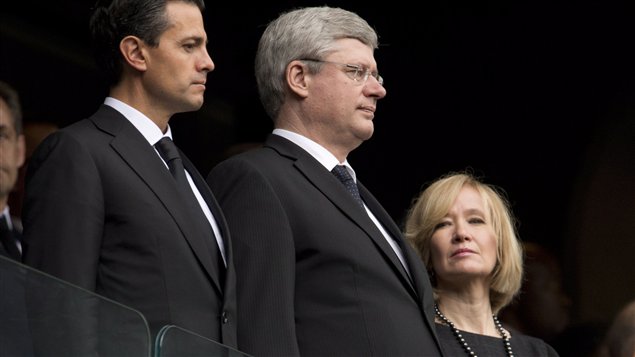A coalition of diverse Canadian political figures was among the tens of thousands who gathered Tuesday at the giant Soweto soccer stadium in Johannesburg to mourn and celebrate the life of Nelson Mandela.
A cold rain–seen by many South African as a blessing–fell throughout the ceremony and appeared to kee many away from the stadium that seats over 90,000.
Prime Minister Stephen Harper was joined by four of his predecessors–Kim Campbell, Jean Chretien, Joe Clark, and Brian Mulroney–for the four-hour ceremony.
Chretien said the exuberance Tuesday made it unlike any memorial he had
seen and noted that his government made Mandela an honorary Canadian citizen in 2001. (Four others have accepted honorary Canadian citizenship: Raoul Wallenberg, Tenzin Gyatso, the 14th Dalai Lama, Aung San Suu Kyi and His Highness the Aga Khan.)
As the memorial unfolded, a muted tribute rang out over the Canadian capital of Ottawa as the Peace Tower bells played the song Nkosi Sikelel’ iAfrika, the official anthem of Mandela’s African National Congress during the apartheid era and a symbol of the anti-apartheid movement
People at the Soweto ceremony heard from–among others–South African Bishop Desmond Tutu, Mandela’s close friend and advisor, and U.S. President Barack Obama.
Harper and his wife, Laureen, were also joined by former governors general Adrienne Clarkson and Michaelle Jean, Assembly of First Nations national Chief Shawn Atleo and Gaston Barban, Canada’s high commissioner to South Africa.
At first it appeared that only 11 members of the Canadian delegation would be allowed inside the stadium following an earlier decision by the South African protocol office.
The Prime Minister’s Office was told that Opposition Leader Tom Mulcair, as well as four Canadian premiers and several MPs who made the 18-hour journey for the service, would not be allowed inside. However, all of the Canadians entered the stadium during a confusion that reigned at security checkpoints as thousands of people poured through.
Alberta Premier Alison Redford, one of the four premiers attending, worked for Mandela in the early 1990s, when South Africa was in transition out of apartheid and developing a new constitution.
“He was a very tough taskmaster,” Redford said of Mandela. “He always had a sense of humour and I think that’s what kept him on track.”
Mandela’s body will lie in state for three days at the Union Buildings in Pretoria, before the burial Sunday in his rural childhood village of Qunu in Eastern Cape Province.







For reasons beyond our control, and for an undetermined period of time, our comment section is now closed. However, our social networks remain open to your contributions.